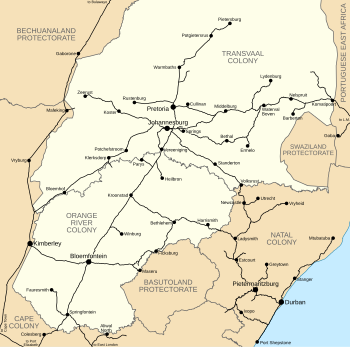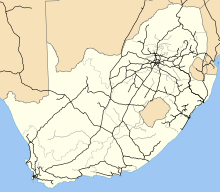Different methods of transportation in South Africa include roads, railways, airports, water, and pipelines for petroleum oil. The majority of people in South Africa use informal minibus taxis as their main mode of transport. BRT has been implemented in some South African cities in an attempt to provide more formalised and safer public transport services. These systems have been widely criticised due to their large capital and operating costs. A "freeway" is different from most countries as certain things are forbidden which include certain motorcycles, no hand signals, and motor tricycles. South Africa has many major ports including Cape Town, Durban, and Port Elizabeth that allow ships and other boats to pass through, some carrying passengers and some carrying petroleum tankers.

The Blue Train travels an approximately 1,600-kilometre (990 mi) journey in South Africa between Pretoria and Cape Town. It is one of the most luxurious train journeys in the world. It boasts butler service, two lounge cars, an observation car, and carriages with gold-tinted picture windows, in soundproofed, fully carpeted compartments, each featuring its own en-suite. The service is promoted as a "magnificent moving five-star hotel" by its operators, who note that kings and presidents have travelled on it.

Rail transport in South Africa is an important element of the country's transport infrastructure. All major cities are connected by rail, and South Africa's railway system is the most highly developed in Africa. The South African rail industry is publicly owned.
Shosholoza Meyl is a division of the Passenger Rail Agency of South Africa (PRASA) that operates long-distance (intercity) passenger rail services. It operates various train routes across South Africa, carrying approximately 4 million passengers annually. Before 2009, Shosholoza Meyl was a division of Spoornet, but it was transferred after the formation of PRASA.
Eswatini Railways (ESR), formerly known as Swaziland Railway or Swazi Rail, is the national railway corporation of Eswatini.

Portos e Caminhos de Ferro de Moçambique is a state-owned company that oversees the railway system of Mozambique and its connected ports.

The Passenger Rail Agency of South Africa (PRASA) is a South African state-owned enterprise responsible for most passenger rail services in the country.

Bellville mainline railway station is a railway station in the town of Bellville, Western Cape, South Africa. It is the second-biggest station in the Metrorail Western Cape railway network, after the Cape Town terminus. All trains on Metrorail's Northern Line pass through Bellville, and one branch of the Central Line also terminates there. It is also a stop for Shosholoza Meyl trains that terminate in Cape Town.
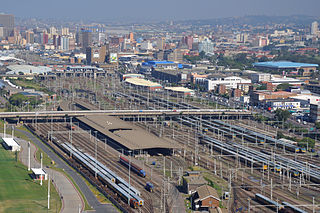
Durban railway station is the central railway station in the city of Durban, South Africa, located between Umgeni Road and Masabalala Yengwa Avenue just to the north of the central business district. It is the terminus of Shosholoza Meyl long-distance services from Johannesburg and Cape Town, and the hub of a network of Metrorail commuter rail services that stretch as far as KwaDukuza (Stanger) to the north, Kelso to the south, and Cato Ridge inland.
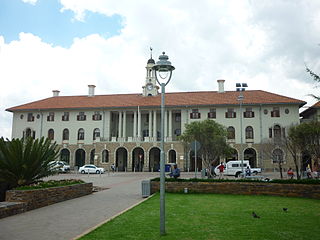
Pretoria railway station is the central station in Pretoria, the executive capital of South Africa. It is located between Pretoria's central business district and Salvokop, in a 1910 building designed by Herbert Baker. It is the terminus of various Metrorail commuter rail services in the northern part of Gauteng, and a stop on Shosholoza Meyl inter-city services from Johannesburg to Polokwane and Nelspruit. Pretoria is also the northern terminus of the luxury Blue Train service from Cape Town. Platforms and tracks for the Gautrain rapid-rail service are adjacent to the main-line station.

The Transnet Freight Rail Class 15E of 2010 is a South African electric locomotive.
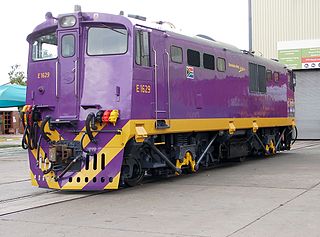
The South African Railways Class 6E1, Series 5 of 1974 was an electric locomotive.
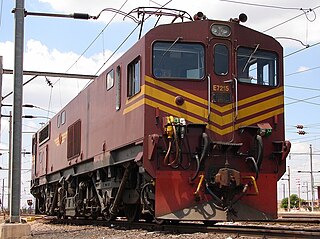
The South African Railways Class 7E2, Series 2 is an electric locomotive. South African Railways placed 40 Class 7E2, Series 2 electric locomotives with a Co-Co wheel arrangement in service in 1983.

The South African Railways Class 34-000 of 1971 is a diesel-electric locomotive.

The South African Railways Class 35-200 of 1974 is a diesel-electric locomotive.

The South African Railways Class 37-000 of 1981 is a mainline diesel-electric locomotive.

The Spoornet Class 39-000 of 2006 is a South African diesel-electric locomotive from the Spoornet era.

The Transnet Freight Rail Class 43-000 of 2011 is a South African diesel-electric locomotive.
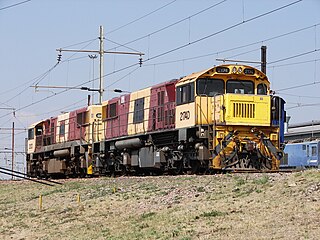
The Queensland Railways 2170 class is an Australian diesel-electric locomotive.

Pretoria–Maputo railway, also called Delagoa Bay railway, Iron railway and Eastern railway, is a railway that connects the city of Maputo, Mozambique, to the city of Pretoria, in South Africa. It is 567 km long, in 1067 mm gauge. The Mozambican section, between Maputo and Ressano Garcia, is managed by the state-owned Mozambique Ports and Railways (CFM) company, and it is officially known in Mozambique as the Ressano Garcia Line; in turn, on the South African stretch, between the town of Komatipoort and city of Pretoria, the administration is done by the company Transnet Freight Rail.

